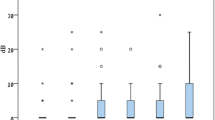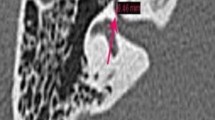Abstract
In the present study, we evaluated the diameter of internal acoustic canal in patients with Bells palsy to investigate the role of anatomical differences of the temporal bone in etiology of Bell’s palsy. Sixty-four patients who were diagnosed as Bells Palsy and temporal bone computed tomography imagings of them were included into the study group (Group 1). The control group (Group 2) was consisted of 35 healthy subjects without Bell’s Palsy. All patients had temporal bone computed tomography imaging. The internal auditory canal inlet, mid-canal, outlet and canal lengths were measured at the most distinctive cross-section of the seventh and eighth cranial nerves bifurcation. In the study group, Bells palsy was on the right side in 26 patients (40.6 %) and on the left side in 38 patients (59.4 %). Initial House–Brackmann (HB) score was HB-2 in 29 patients (45.3 %), HB-3 in 18 patients (28.1 %), HB-4 in 13 patients (20.3 %) and HB-5 in 4 patients (6.2 %). At 6-month evaluation, HB-score of the patients were HB-1 in 37 patients (57.8 %), HB-2 in 25 patients (39.1 %) and HB-3 in 2 patients (3.1 %). Internal auditory canal (IAC) measurements of the groups showed that there were no significant differences between the measurements of right-mid canal, right canal length; and left canal outlet and left canal length of the study and control groups. Right inlet and outlet; and left inlet and mid-canal values of the study group (Bell’s palsy) were significantly lower than those of the control group. In Bell’s palsy group, left inlet, outlet and canal length values were significantly higher than those of the right ones. Correlation analysis showed that there were no significant correlation between paralysis side; initial HB stage; and IAC measurement results. In patients with higher initial HB score, their 6-month later HB-score was also higher. In patients with higher 6-month HB score; R canal inlet, R mid-canal, L-canal inlet, and L-mid canal values were lower. Lower IAC inlet and mid-canal values were detected in patients with Bell’s palsy. Therefore narrow IAC inlet and mid-canal values may be one of the risk factors for Bell’s palsy.


Similar content being viewed by others
References
McCaul JA, Cascarini L, Godden D, Coombes D, Brennan PA, Kerawala CJ (2014) Evidence based management of Bell’s palsy. Br J Oral Maxillofac Surg 52(5):387–391. doi:10.1016/j.bjoms.2014.03.001 Epub 2014 Mar 27
Burgess LP, Yim DW, Lepore ML (1984) Bell’s palsy: the steroid controversy revisited. Laryngoscope 94:1472–1476
Kefalidis G, Riga M, Argyropoulou P, Katotomichelakis M, Gouveris C, Prassopoulos P et al (2010) Is the width of the labyrinthine portion of the fallopian tube implicated in the pathophysiology of Bell’s palsy? A prospective clinical study using computed tomography. Laryngoscope 120:1203–1207
Gilden DH (2004) Bell’s palsy. N Engl J Med 351:1323–1331
Engström M, Berg T, Stjernquist-Desatnik A, Axelsson S, Pitkäranta A, Hultcrantz M et al (2008) Prednisolone and valaciclovir in Bell’s palsy: a randomised, double-blind, placebo-controlled, multicentre trial. Lancet Neurol 7:993–1000
Gantz BJ, Gmur A, Fisch U (1982) Intraoperative evoked electromyography in Bell’s palsy. Am J Otolaryngol 3:273–278
Jenkins H, Herzog J, Coker N (1985) Bell’s palsy in children. Cases of progressive facial degeneration. Ann Otol Rhinol Laryngol 94(4 pt 1):331–336
WMA, Declaration of Helsinki. Ethical Principles for Medical Research Involving Human Subjects, in 59th WMA General Assembly, W.M. Association, Editor: Seoul, 2008
Kumral TL, Yıldırım G, Yılmaz HB, Ulusoy S, Berkiten G, Onol SD, et al. Is it necessary to do temporal bone computed tomography of the internal auditory canal in tinnitus with normal hearing? Sci World J Volume 2013 (2013)
Yanagihara N, Honda N, Hato N, Murakami S (2000) Edematous swelling of the facial nerve in Bell’s palsy. Acta Otolaryngol 120:667–671
Sugita T, Murakami S, Yanagihara N, Fujiwara Y, Hirata Y, Kurata T (1995) Facial nerve paralysis induced by herpes simplex virus in mice: an animal model of acute and transient facial paralysis. Ann Otol Rhinol Laryngol 104:574–581
Tien R, Dillon WP, Jackler RK (1990) Contrast-enhanced MR imaging of the facial nerve in 11 patients with Bell’s palsy. AJR Am J Roentgenol 155:573–579
Fisch U (1981) Surgery for Bell’s palsy. Arch Otolaryngol 107:1–11
Fisch U, Esslen E (1972) Total intratemporal exposure of the facial nerve. Arch Otolaryngol 95:335–341
May M, Schaitkin B (2000) The facial nerve, 2nd edn. Thieme Medical, New York
Conflict of interest
The authors declare that there is no conflict of interest.
Author information
Authors and Affiliations
Corresponding author
Rights and permissions
About this article
Cite this article
Yilmaz, H.B., Safak Yalcin, K., Çakan, D. et al. Is There a Relationship Between Bell’s Palsy and Internal Auditory Canal?. Indian J Otolaryngol Head Neck Surg 67, 319–323 (2015). https://doi.org/10.1007/s12070-014-0809-0
Received:
Accepted:
Published:
Issue Date:
DOI: https://doi.org/10.1007/s12070-014-0809-0




